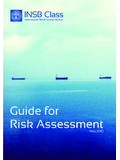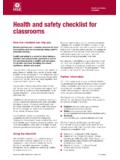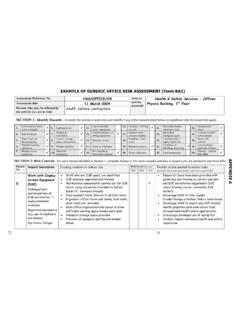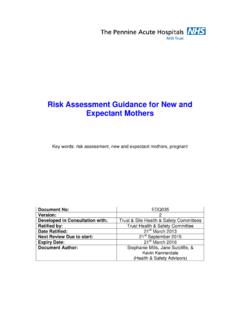Transcription of Sandwich panels for external cladding – fire safety issues ...
1 Sandwich panels for external cladding fire safety issues and implications for the risk assessment process. A report by Dr Gordon M E Cooke BSc PhD CEng MIMechE MICE FIFireE International fire safety Consultant and Visiting Professor, Department of Civil Engineering, City University, London November 2000 Commissioned by Eurisol UK mineral Wool Association 2 Sandwich panels for external cladding fire safety issues and implications for the risk assessment process. Executive Summary This report demonstrates that fire safety guidance is essential for external Sandwich panel cladding the building envelope. The report maintains that the risk posed by combustible-cored Sandwich panels in the external building envelope, as well as that for internal partitioning, should be recognised by building owners, employers and designers for the purposes of their risk assessments.
2 It is contended that none of the risk assessment guidance currently available helps the specifier to come to a decision as to whether or not the risk, in using combustible-cored panels is acceptable Combustible-cored Sandwich panels are today being used in building envelopes other than those for low life risk warehousing and temperature-controlled environments. Schools, hospitals, prisons, retail outlets and other public buildings make use of this type of construction without appropriate regulation or guidance. Sandwich panel construction offers fast track, cost effective energy efficient building envelopes, with an array of aesthetically pleasing shapes and finishes.
3 Sandwich panels which incorporate non-combustible insulation cores and properly attached steel faces, can be safely specified in all relevant building applications. Sandwich panels with combustible foamed plastic insulation cores polystyrene and polyurethane materials carry the risk of being a potential hazard in fire . Official DETR guidance currently recognises this risk in Appendix F of Approved Document B of the Building Regulations fire safety 2000 Edition, but only for internal structures. However it is advisable that a risk assessment be carried out to determine the suitability of combustible-cored Sandwich panels for external cladding and in other applications.
4 The Report reviews a number of ad hoc fire tests currently being used to provide data on the fire performance of Sandwich panels . It demonstrates that the fire sources used in these tests are smaller than the fire sources generally present in UK buildings. Therefore the data obtained from such tests could give employers, designers and regulators a misleading view of fire safety . Where a risk to property and business economies exists, and where a risk of environmental contamination [air and water] is identified, then employers and designers should be appraised of the advantages of choosing Sandwich panels with non-combustible insulation cores. CONTENTS 3 Glossary of terms Introduction fire risk assessment A qualitative understanding of the hazard of combustible Sandwich panels .
5 The core material context The mechanical hazards of Sandwich panels The combustible hazards of Sandwich panels Vertical transport of panel effluent Where the fire effluent travels fire load considerations fire loads in buildings fire loads used in ad hoc fire tests for Sandwich panels Flashover can it be caused by Sandwich panels ? fire checklist for specifiers and employers Factors to consider in a fire risk assessment for combustible-cored panels Conclusions References Annexes Annex 1: IFE articles When are Sandwich panels safe in fire ? Parts 1, 2 & 3 Annex 2: Approved Document B Appendix F Annex 3: fire loads of Sandwich panels 4 GLOSSARY OF TERMS fire terms fire effluent The total gaseous, particulate or aerosol effluent from combustion products.
6 fire hazard The potential for loss of life or injury and/or damage to property by fire fire risk Probability of fire causing a loss of life or injury and/or damage to property fire load The sum of the calorific energies which could be released by the complete combustion of all the combustible materials in a space, including the facings of the walls, partitions, floor and ceiling. fire load density The fire load per unit floor area fire retardant A substance added, or a treatment applied to, a material in order to suppress, significantly reduce or delay the combustion of the material fire risk Probability of fire causing a loss of life or injury and/or damage to property Flashover The rapid transition to a state of total surface involvement in a fire of combustible materials within an enclosure Fully developed fire The state of total involvement of combustible materials in a fire Heat release rate The calorific energy released per unit time by a material during combustion under specified test conditions Non-combustible Not capable of undergoing combustion under specified test conditions Reaction to fire The fundamental behaviour of a material in fire
7 Described in terms of rate of heat release, potential energy release, surface burning, smoke release, tendency to produce burning 5droplets or particles. Resistance to fire The ability of an element of building construction to fulfil for a stated period of time the required load-bearing function [resist collapse], integrity [resist fire penetration] and insulation [resist the transfer of excessive heat] Product term Sandwich panel A composite product comprising outer thin rigid metal sheet (usually coated steel or aluminium alloy) either side of a bonded core of insulating material. Core insulating materials Polyurethane foam (PUR) An organic insulation material made from a reactive mixture of two principal liquid components and a number of additives, to produce highly cross linked polymers with a closed cell structure.
8 The liquid components may be a hydroxyl group of a polyester, polyether, or polyalcohol with a di-isocyanate. The foam produced will not normally be ignited by a small heat source, but a larger flame will cause ignition and fire spread, with abundant smoke and toxic decomposition giving off hydrogen cyanide, oxides of nitrogen, and carbon monoxide. The Flash Ignition temperature is 320-420 degrees C. The self ignition temperature is 420-550 degrees C. Polyisocyanurate foam (PIR) Polyisocyanurate is made in the same way as polyurethane, but the ratio between the components and the type of additives is usually different, to produce a polymer containing chemical bonds with a higher temperature resistance.
9 The increase in the decomposition temperature depends entirely on the concentration of these bonds and on the aromatic content. Process control factors are more critical than with PUR. The smoke and decomposition products are similar to PUR. Polystyrene foam Expanded Polystyrene (EPS) is an organic insulation material made by the addition of catalysts and a blowing agent (normally pentane) to a styrene monomer derived from crude oil, by a combination of ethylene and benzene. The bead is then made into a foamed product containing entrapped air. Extruded Polystyrene (XPS) is manufactured, using the same materials as EPS, by a continuous extrusion process where blowing agents are added to produce a closed cell material.
10 The process creates superior properties to EPS. 6 The flash ignition temperature is 290-350 degrees C. The self ignition temperature is 490 degrees C. When exposed to a small flame, polystyrene melts and shrinks away from the heat source. A larger heat source will produce flaming molten droplets and rapid emission of dense black smoke/soot. Stone woo] Stone or rock wool is produced by melting naturally occurring rock with coke and dolomite and/or slag. The molten rock is formed into stone wool by contact with spinning wheels. The woollen structure entraps air, and is bonded together with cured resin, to form non-combustible insulation in a variety of densities with very low calorific content.







